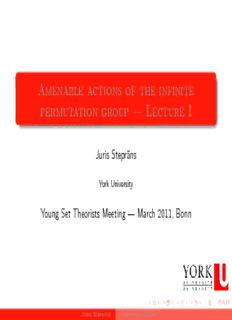Table Of ContentAmenable actions of the infinite
permutation group — Lecture I
Juris Stepr¯ans
YorkUniversity
Young Set Theorists Meeting — March 2011, Bonn
JurisStepra¯ns Amenableactions
Lebesque described his integral in terms of invariance under
translation and countable additivity (actually, monotone
convergence) an asked whether this provided a
characterization.
Banach disproved this by constructing a finitely additive,
translation invariant measure on the circle that was different
from the Lebesque integral in that it is defined on all subsets
of the circle.
It was also possible to define such a measure on R that gives
R finite measure.
The investigation of such measures led to the
Banach-Tarski-Hausdorff Paradox. In his study of this paradox
von Neumann introduced the notion of an amenable group.
JurisStepra¯ns Amenableactions
Definition
A mean on a discrete group G is a finitely additive probability
measure on G. For X ⊆ G and g ∈ G define gX = {gx | x ∈ X}.
A mean µ is said to be left invariant if µ(gX) = µ(X) for all
g ∈ G and X ⊆ G.
Means on locally compact groups can be defined in a similar spirit.
JurisStepra¯ns Amenableactions
Definition
A discrete group is called amenable if there exists a left invariant
mean on it.
Example
Finite groups are amenable.
Example
Z is amenable.
A naive approach would be to construct a mean on Z in the same
way that ultrafilters on N are constructed. While this is possible,
the details are considerably more involved than the ultrafilter
construction. Note that a mean can never be two valued.
JurisStepra¯ns Amenableactions
To construct a mean on Z it is useful to identify means on a
discrete group G as elements of (cid:96)∗ (G). Given a mean µ on G
∞
define m : (cid:96) (G) → R by
µ ∞
(cid:90)
m (f) = f(g)dµ(g)
µ
taking care about the lack of countable additivity of µ: Note that
m (gf) = m (f) if µ is left invariant. (Here gf(h) = f(g−1h).)
µ µ
On the other hand, if m ∈ (cid:96)∗ (G) is left invariant as above, then
∞
defining µ (A) = m(χ ) yields a left invariant mean.
m A
JurisStepra¯ns Amenableactions
Recall that (cid:96) (G)∗ = (cid:96) (G) with f(h) = (cid:80) f(g)h(g) where
1 ∞ g∈G
h ∈ (cid:96) (G) and f ∈ (cid:96) (G). For k ≥ 1 let m ∈ (cid:96) (Z) be defined by
1 ∞ k 1
(cid:40)
1/(2k +1) if |j| ≤ k
m (j) =
k
0 otherwise
and note that (cid:107)m (cid:107) = 1. Hence the m can be identified with
k 1 k
elements of unit ball of (cid:96)∗ (Z) and so they have a weak∗ complete
∞
accumulation point m in the unit ball of (cid:96)∗ (Z) — in other words,
∞
µ (Z) = 1.
m
It suffices to show that m(n+f) = m(f) for n ∈ Z and f ∈ (cid:96) (Z).
∞
JurisStepra¯ns Amenableactions
To see this note that
k
(cid:88) 1 (cid:88)
m(f) = limf(m ) = f(j)m (j) = f(j)
k k
k 2k +1
j∈Z j=−k
while
k
(cid:88) 1 (cid:88)
m(n+f) = lim(n+f)(m ) = f(j−n)m (j) = f(j−n)
k k
k 2k +1
j∈Z j=−k
and note that |(cid:80)k f(j)−(cid:80)k f(j −n)| ≤ n(cid:107)f(cid:107) and hence
j=−k j=−k ∞
n(cid:107)f(cid:107)
∞
m(f)−m(n+f) = lim = 0
k 2k +1
JurisStepra¯ns Amenableactions
Example
F is not amenable.
2
To see this suppose that µ is a left invariant probability measure
on F . Think of F as all reduced words on the two letter alphabet
2 2
{a,b} with identity the empty word ∅. If B denotes all words
x
beginning with x ∈ {a,b,a−1,b−1} then
F = B ∪B ∪B ∪B ∪{∅}. Moreover, aB and B form a
2 a b a−1 b−1 a−1 a
partition of F and so do bB and B . Hence, by left invariance
2 b−1 b
1 = µ(aB )+µ(B ) = µ(B )+µ(B )
a−1 a a−1 a
1 = µ(bB )+µ(B ) = µ(B )+µ(B )
b−1 b b−1 b
yielding a contradiction.
JurisStepra¯ns Amenableactions
Amenable groups are preserved by subgroups. Why? Let µ be a
left invariant probability measure on G and H a subgroup of G.
Restricting µ to H works unless µ(H) = 0. Let X be such that
{Hx} is a maximal family of right cosets of H. Define
x∈X
(cid:83)
µ (A) = µ( Ax). It is easy to see that µ is finitely additive
H x∈X H
and µ (H) = 1. To see that it is left invariant, let h ∈ H. Then
H
(cid:91) (cid:91) (cid:91)
µ (A) = µ( hAx) = µ(h Ax) = µ( Ax) = µ (A)
h H
x∈X x∈X x∈X
Hence SL (R) and S(N) — the full symmetric group on N — are
2
not amenable since both contain a copy of F . It was a conjecture
2
of von Neumann that the amenable groups could be characterized
as precisely those that do not contain a copy of F . This was
2
disproved by Olshanskii.
JurisStepra¯ns Amenableactions
Products of amenable groups are amenable: Hence Zn ×G is
amenable for any finite group. More generally, extensions of
amenable groups by amenable groups are also amenable — in
other words, if N is an amenable normal subgroup of G and G/N
is amenable, then so is G. (Why? Fubini’s Theorem) Quotients of
amenable groups are also amenable. (Why? Use the image
measure.)
Directed unions of amenable groups are amenable. (Why? This
will follow from the Følner Property to be discussed next.) This
raises the question of whether the amenable groups are precisely
those that can be obtained from finite groups and Z by subgroups,
quotients, extensions and increasing unions. An example of
Grigorchuk shows that this is not the case.
JurisStepra¯ns Amenableactions
Description:Banach-Tarski-Hausdorff Paradox. In his study of this paradox von Neumann introduced the notion of an amenable group. Juris Stepr¯ans. Amenable

